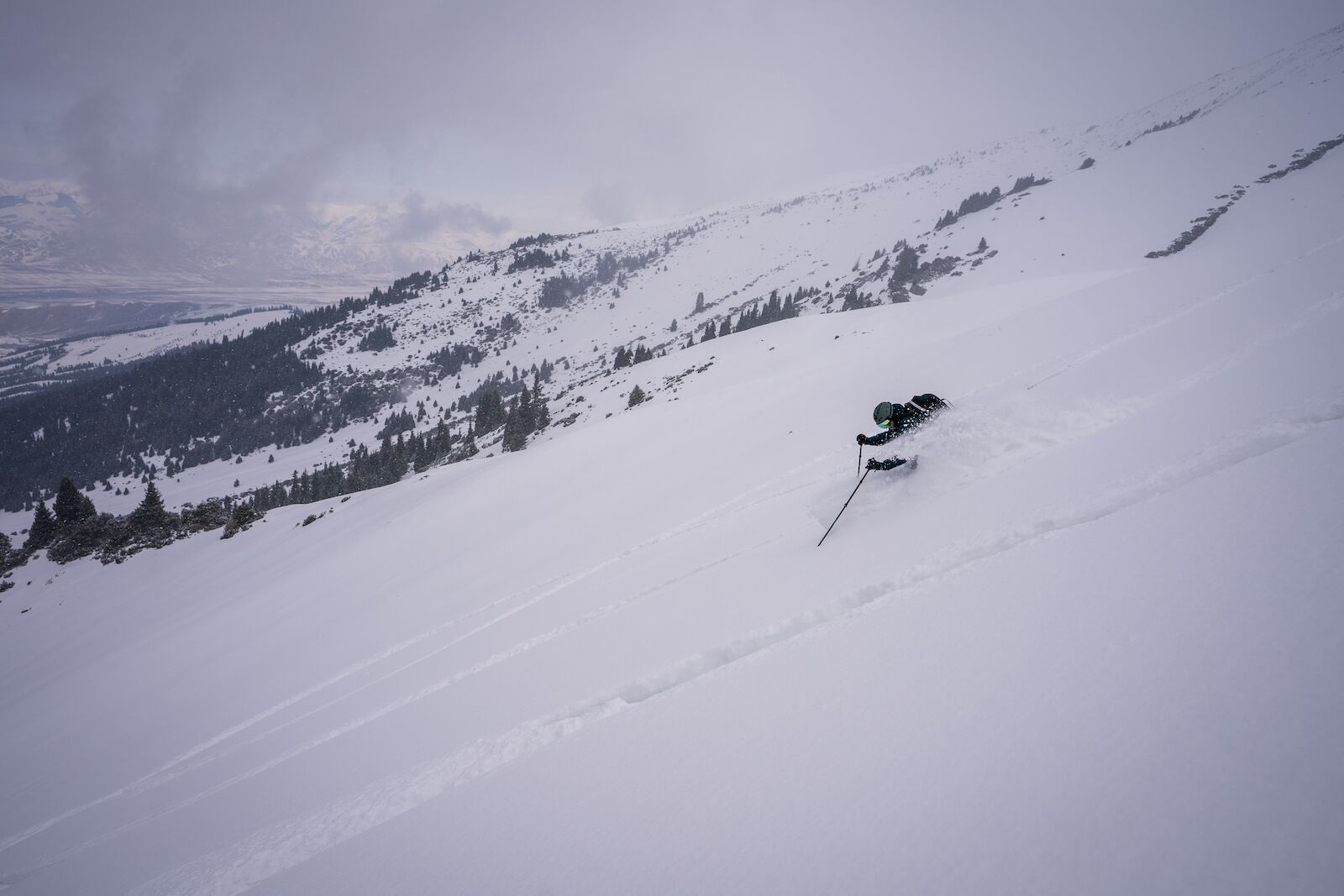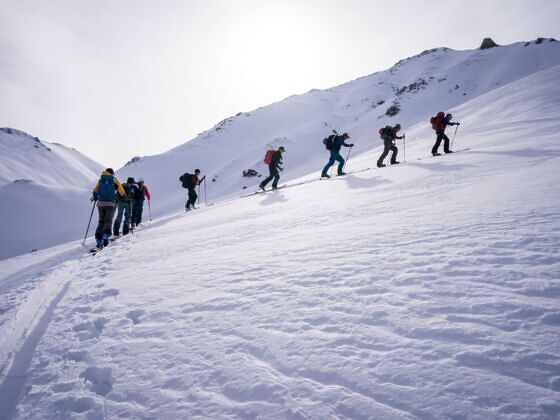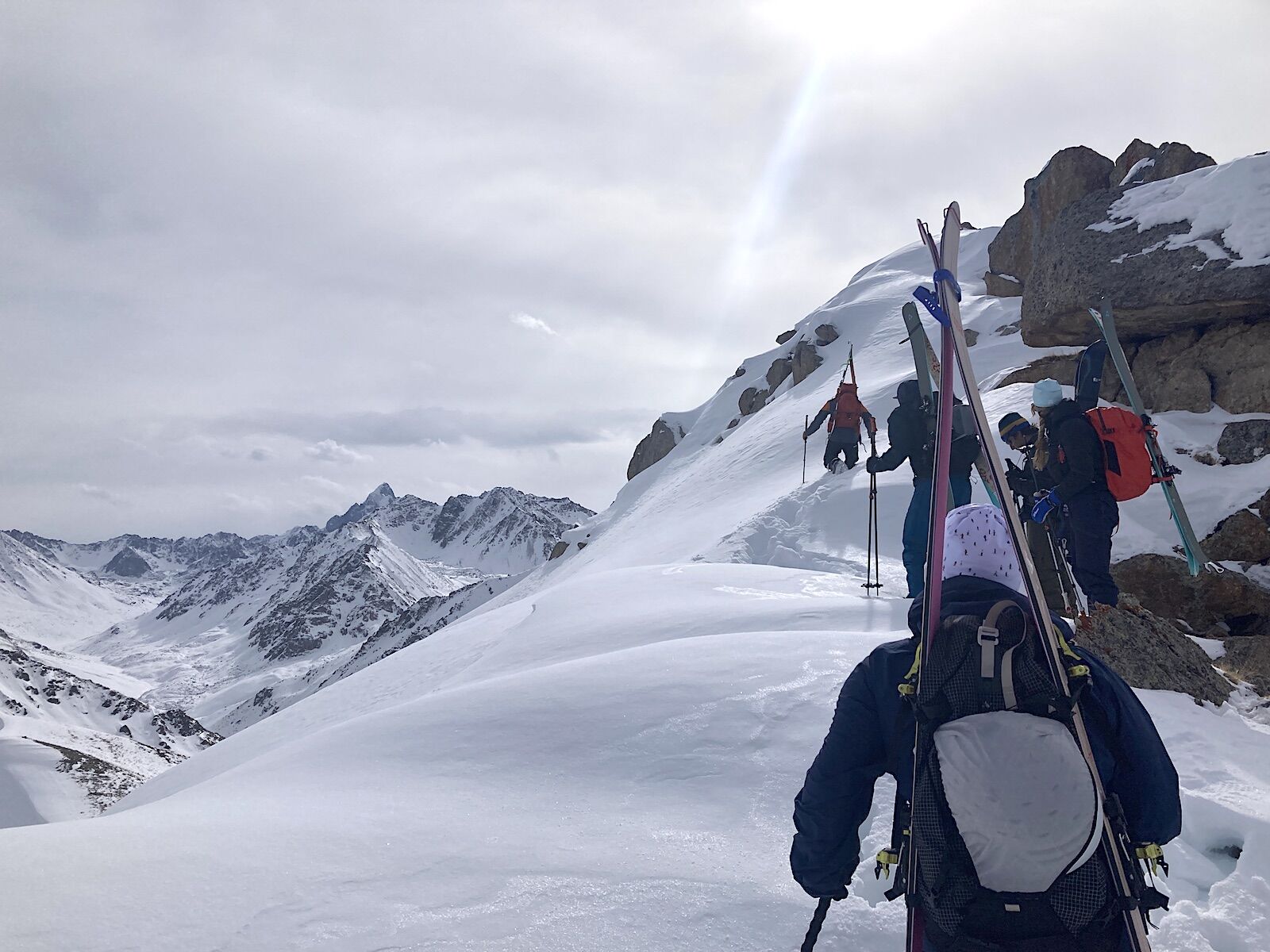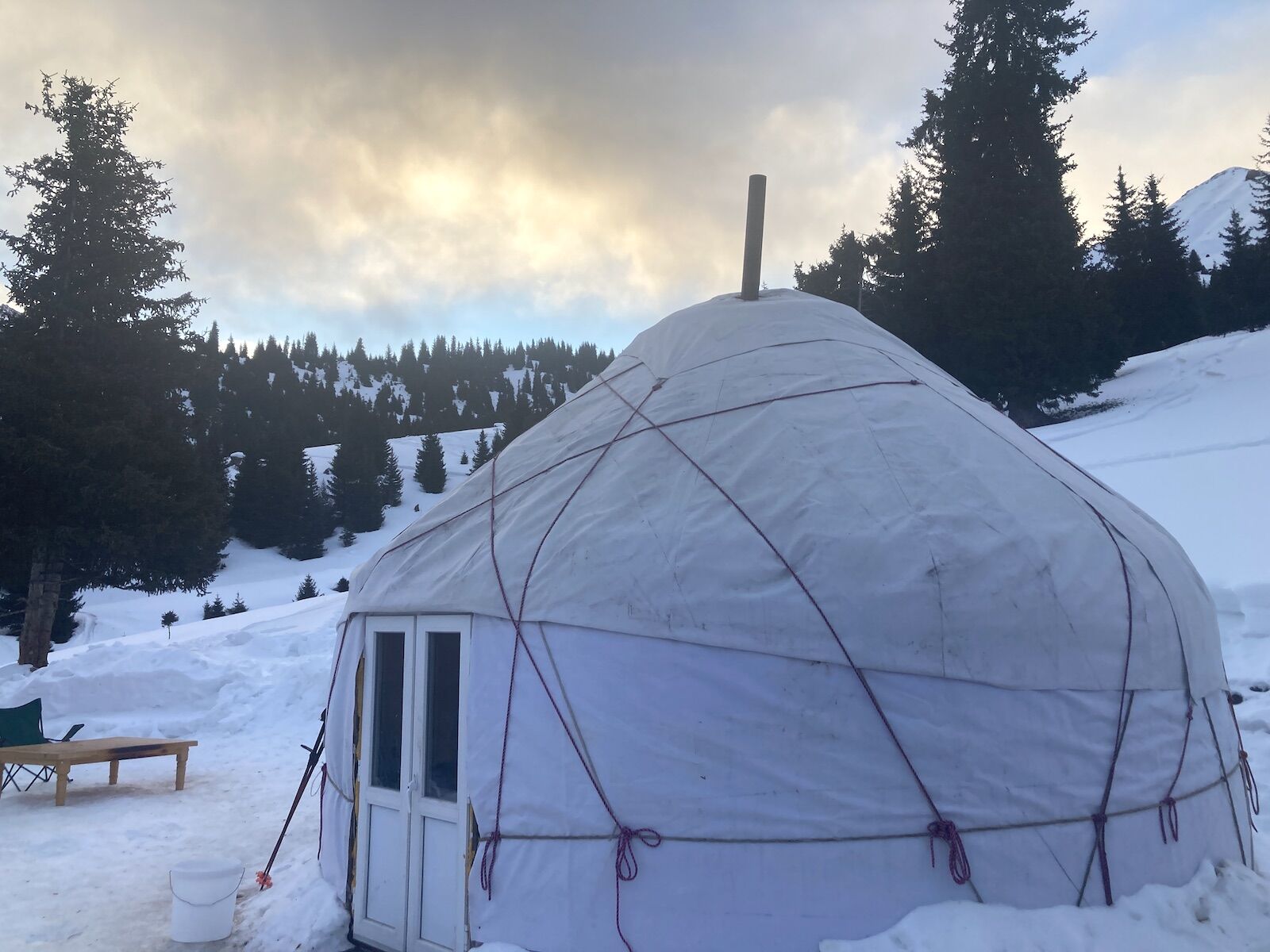A southwesterly wind had ripped through the high alpine of Kyrgyzstan’s Tien Shan mountains overnight, depositing two inches of faceted powder onto the south-facing slopes surrounding our group of nine skiers and snowboarders. White, rocky peaks surrounded us in all directions. Cold beads of snow whipped my face as I stopped to remove a sandwich from the hip belt pouch of my ski touring backpack. We’d reached a decision point in our ascent of the 12,000-foot summit of Alpe Tur peak, an objective our group of backcountry skiers and riders would reach twice throughout a seven-day, yurt-based ski tour with the tour operator 40 Tribes. Half a dozen steep and inviting ski lines descended from the peak, and we planned to ski as many of them as conditions – and time – allowed.
I touched down in Bishkek, the Kyrgyz capital, in early February, unsure of what to expect. Immersive ski tour experiences like this tend to put you face-to-face with your social and on-mountain weaknesses. I worried whether my level of fitness would be on par with the group’s, or if my perceived comfort in riding big-mountain terrain would translate across the Pacific. I’d overpacked to the tune of having two jackets and multiple garments that never left my duffel. But what I found on the ground at Jalpak Tash, as the alpine yurt camp is called, wasn’t a group of boisterous mountaineers but a cohort of curious adventurers as intrigued by the people we’d meet and the cultural experiences we’d share as they were in the ski lines we’d check off. Collectively we stood to gain much in new perspectives.
Building an outdoor economy in Kyrgyzstan

Who’s dropping in first? Photo: Connor Nash
“It’s sugar from top to bottom,” said Sam Thackery, our guide with 40 Tribes, a backcountry ski expedition operator that for 13 years has hosted these trips based high in the Tien Shan. In backcountry parlance, “sugar snow” refers to thin, conically-shaped flakes of snow that fail to congeal together. This often signals hazardous avalanche conditions, but in our case, the absence of any solidified (and therefore more dangerous) layer of snow on top meant the day could proceed as planned.
This was day two of seven spent ski touring the peaks above our yurt camp. We spent nights drinking Baltika, Russia’s top domestic beer, over games of Yahtzee. Each day we hit it hard and then hit the sack around 8 o’clock, exhausted from spending the bulk of our daylight hours on the skin track. Kyrgyzstan’s Tien Shan range is far removed from the polished pistes of Aspen or Whistler – the basis of its appeal to dedicated backcountry skiers. 40 Tribes operates backcountry ski and snowboard tours across the globe that plunge guests into cultural immersion along with the fresh powder, but Kyrgyzstan is the company’s namesake and most popular offering. Founder Ryan Koupal started the company in 2010 after majoring in Mandarin language studies in college followed by several years guiding high school students through central and east Asia with an operator called Where They Be Dragons. It was then that he set his eye on skiing the Tien Shan.
“2008 was the first time that marrying my passions for wild international travels and splitboarding came to be,” Koupal says. “I figured, why don’t we make something happen that is going to benefit locals and potentially the tourism industry. That’s where this whole concept came to be, with skiing from a yurt in the backcountry here.”
The name “40 Tribes” stems from a founding epic of the Kyrgyz people under Manas, who united the 40 tribes of Kyrgyzstan to fight against tyranny and come together as a free people (the folklore and history of Manas and his quest is indeed an epic tale, though be prepared if you choose to read up on it — the legend historically takes up to three weeks to recite orally).
Under Koupal’s guidance, 40 Tribes has played a significant role in developing a culture of outdoor recreation in the region. Kyrgyzstan saw intermittent ski development during Soviet times, but until he and his friends showed up to scout the region, backcountry skiing wasn’t a thing here. His original vision was for a film that told the story of the potential for ski tours in the area, and while the project never came to fruition, 40 Tribes’ destination ski trips were born.
The outfitter employs local guides, chefs, and hospitality operators to round out a crew of Western-certified mountain guides. The diverse nature of its staff allows the company to bring unique perspectives, skills, and resources to the table. By working together, 40 Tribes facilitates greater collaboration with the community and ensures that the economic and cultural benefit extends both ways. Since beginning work with 40 Tribes, Kasidin Musaev, our local Kyrgyz guide, has obtained guiding certification through the Kyrgyz Mountain Guide Association and looks to bring his powder-slashing skills across international borders in the coming seasons. The camp’s chef, Nurbek Kasymov, has used part of his earnings to send his daughter to school in the nearby city of Karakol.
“This was not happening before we showed up and introduced the idea,” Koupal says. “There are a lot of tourists who now have Kyrgyzstan on their radar, and who come here for backcountry touring. We’ve had 450 clients from more than a dozen countries, all coming to Kyrgyzstan to ski with us. It’s a pretty cool thing. We’re getting people from all over the world who are deeply interested in off-the-beaten-track international travel, and they’re using backcountry skiing as a means of exploring these cultures.”
On the surface, this trip was about skiing. Yet a deeper look reveals so much more. Our crew was anchored by Nansen and Aly, a fit couple from British Columbia accustomed to long days in the backcountry. Also on board in addition to myself were Payton, a young climber from Ohio; Todd, a financier from Colorado; and Amy, a doctor also from British Columbia. Over morning coffee in the yurt, we often discussed global affairs, differing personal opinions finding points of agreement on a love of nature and a desire to experience and protect it.
And of course, we all bonded over the shared desire to shred deep powder. Descents from the surrounding peaks often topped 2,000 vertical feet, our turns amplified by the loud shouts of joy that so often accompany cold face shots of snow. I couldn’t help but smile each time we reached the top of a big line – the ascents took multiple hours and, though fueled by hearty Kyrgyz-style meals at camp and no shortage of Clif Blocks and Honey Stingers en route, my thighs purveyed a steady burn throughout the week.
High in the Tien Shan mountains, the foot of the Himalaya

Wide open turns are the draw for skiers in the Tien Shan. Photo: Connor Nash
Thirteen years on, Koupal could not have planned a big mountain experience that provides a better overview of modern humanity’s struggles and the points of unity required to overcome them. Since Russia’s invasion of Ukraine in 2021, Kyrgyzstan has served as a landing point for Russian men seeking to avoid military conscription. Thousands have posted up in Kyrgyzstan since the invasion, three of whom skied unannounced into our camp one afternoon.
We’d just arrived back after a long day in the alpine. I’d swapped my snowboard boots for a pair of Baffin Down Booties and a cold beer. I was at first taken aback by their arrival – three scruffy dudes with snowshoes strapped to their packs, loudly conversing in Russian, wasn’t on the agenda. But the guys were friendly enough and were equally as curious about what we were doing camped out up here. Our Kyrgyz guide, fluent in Russian, chatted with them for a while and learned that two of the guys had recently relocated from Siberia to the Kyrgyz city of Karakol and taken jobs as snowboard instructors at the local ski hill, dodging Putin’s war to battle the Kyrgyz high country instead. Seeing the smoke rise above our yurt camp, they’d pulled in to say hello on their way back to the trailhead after their own day of backcountry exploration.
Growing up in the States, I’d heard many stories of young men dodging the military draft during the Vietnam War in the 1960s. From what I know about the justifications behind said war, I’ve never blamed them for that decision, whether or not I’d have done the same. Our local guide, however, felt the Russian snowboard instructors’ opposition to the current conflict could have been better directed. He explained to me, is power in numbers not the greatest power of the people? The countries where the people are poor but have control are really free – a statement conveying both how the Kyrgyz people feel about their place in the democratic world in comparison to their neighbors, and the belief that the sheer number of Russians escaping the draft could band together and rise up to end the conflict, rendering Putin’s government defenseless against a united people.
This reflects the heart of the Kyrgyz people in a country that has faced multiple coup attempts, some successful, since its independence in 1991. Today, people are quick to speak truth to power.
I internally questioned my own ability to stand up to oppression. As we climbed to the 12,000-foot top of Chie Ich peak the next morning, I wondered if I, like our Russian acquaintances, would opt for the path over the hills. Teaching snowboarding to kids is certainly a better gig than fighting in Ukraine. They’d found purpose here, confirmation of the unifying power of the mountains.

Casual conversation over Baltika and Kyrgyz cognac. Photo: Connor Nash
We descended the run in pure bliss. The accomplishment of bagging a new line in the backcountry has for me consistently served as confirmation of choices well played — the execution of situational analysis and awareness. This line was no different. Still, thoughts of the prior evening’s encounter stuck with me throughout our final day in the mountains. This trip had proven to be memorable not just for the peaks climbed and lines ridden, but for the many eye-opening, and often unexpected, moments of cultural clarity.
The bonfire party on our final night in camp gave our tired bodies the chance to let go of the physical pressures of daily climbing and descending, to come together over laughs and stories once more. In the morning, we packed up our gear and hit the skin track for a final run above Jalpak Tash. We then descended from the high country to the village of Ichke-Jerges where a Soviet-era military off-roader waited to lug us back to Karakol. There, we’d spend a night on the town reveling in the accomplishment of our expedition.
We awoke on our penultimate morning in Kyrgyzstan to the peaks surrounding Karakol cloaked in an impenetrable cloud of gray. The van pulled out of town around 10 am en route to Bishkek, our mugs full of gas station coffee and our skin crisped by the cool air of the Tien Shan. My left jacket pocket smelled of spilled sunscreen. My mind, though, burned with both satisfaction and a humble curiosity gleaned by tossing oneself into the unknown, emerging on the other side sore and slightly hungover, yet filled with the pride of knowing a lifetime of passionate progress has resulted in some of the best experiences a vagabond snowboarder could ever have.
The feeling of having done the trip is for me comparable only to the time I spent on tour with a punk rock band in my 20s — a satisfaction born from tasting, if only for a moment, the experience of my heroes. This was the same vision I’d had when I first stepped into a snowboard 25 years ago – to be like Jeremy Jones and stand atop big lines in a faraway place, exhilarated as much by the process as by the result.
I’m fortunate to have had this opportunity. Daily routines and every-persons’ struggles tend to leave little time for pursuing such fruition. Exploring the high country on the other side of the world provided us an escape and allowed different backgrounds, beliefs, and levels of privilege to learn from one another over kick turns, bottomless facets, close calls, and a few changed plans along the way. Canadians, Americans, Russians, and Kyrgyz stood unexpectedly together at Jalpak Tash. Each had come for a different reason. We’d found one another, and had found unity in the windswept peaks of the Tien Shan.



